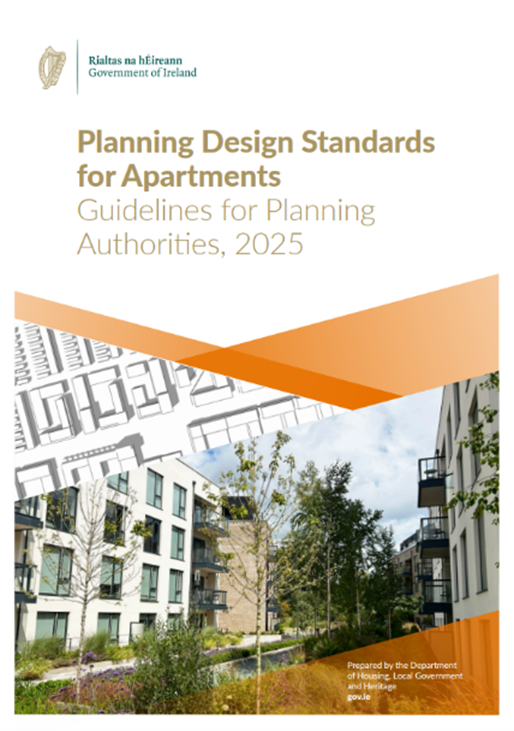17. Design Standards for Apartments, Guidelines for Planning Authorities (2025)
On the 8th of July 2025, the Department of Housing, Local Government and Heritage issued the ‘Planning Design Standards for Apartments, Guidelines for Planning Authorities (2025)’ in accordance with Section 28 of the Planning and Development Act 2000 (as amended). These Guidelines replace the ‘Sustainable Urban Housing: Design Standards for New Apartments Guidelines for Planning Authorities (2023’) and all previous iterations, which are now revoked.
Whilst S. 28 of the 2000 Act has been repealed and replaced with the provisions for National Planning Statements, following the partial commencement of Part 3 of the Planning and Development Act 2024, S. 28 Ministerial Guidelines remain in force until revoked or replaced.
Summary of Key Changes
The purpose of the update to the Guidelines is as follows:
- To support the objectives of the ‘National Planning Framework – First Revision (2025)’, which projects a requirement for approximately 50,000 additional households per annum to 2040, and reaffirms the Government’s commitment to compact growth.
- The Government acknowledge that to fulfil this commitment it will require a substantial increase in housing output of all types, and in particular the delivery of apartments at central and accessible urban locations.
- The Guidelines aim to assist in addressing the viability challenges for the delivery of apartments, while safeguarding standards, to address the growing need to supply a greater range of housing typologies.

In terms of the key changes, updated Specific Planning Policy Requirements (SPPRs) and standards are provided to provide more flexibility on apartment mix, reduction in floor area for studios and introduction of a 2 bed 3person and 3 bed 4 person typology, dual aspect ratios, floor-to-ceiling heights, stair/lift core ratios, and private amenity spaces. Further details are included below with a comparison between the 2023 and 2025 Guidelines.
When considered alongside key design changes recently introduced by the Government, including the rent cap reform, VAT reductions on apartment construction, alongside the NPF Implementation: Housing Growth Requirements S. 28 Guidelines, these measures combined aim to improve the viability of apartment development and support the increased delivery of new homes.
Implementation and Transitional Arrangements
The Guidelines apply to planning applications submitted after the issuing of the Guidelines (i.e. the 2023 Guidelines will continue to be enforced for any planning application in the system prior to the 8th of July 2025). However, provisions are being introduced to allow for modifications to existing planning permissions (discussed further below).
Where Specific Planning Policy Requirements (SPPRs) are stated in the Guidelines, they take precedence over any conflicting policies and objectives of statutory plans, including County Development Plans, Local Area Plans and SDZ Planning Schemes (or any future development plan, area plans, SDZ or UDZ planning schemes made under the Planning and Development Act 2024). Where such conflicts arise, these plans should be amended by the relevant planning authority to reflect the content of the Guidelines.
*It is noted that the 2025 Guidelines are subject to a current legal challenge.
Comparison of the 2023 and 2025 Guidelines
| Topic | 2023 Guidelines | 2025 Guidelines |
| Apartment Mix | SPPR 1: Up to 50% 1-bed or studios (with no more than 20–25% studios). No minimum 3-bed requirement. Development plans could specify an alternative mix based on an evidence-based Housing Need and Demand Assessment (HNDA). SPPR 2: Flexibility for unit mix in respect of refurbishment schemes and infill schemes up to 0.25ha. | SPPR 1: No restrictions on unit mix. Only exceptions apply to Part V social housing, cost-rental housing and housing for older persons in accordance with a HNDA. |
| Minimum Apartment Floor Areas | SPPR 3: Studio (1P) – 37 sq.m 1-bed (2P) – 45 sq.m 2-bed (4P) – 73 sq.m 3-bed (5P) – 90 sq.m | SPPR 2: Studio (1P) – 32 sq.m (reduced) 1-bed (2P) – 45 sq.m (unchanged) 2-bed (3P) – 63 sq.m (new) 2-bed (4P) – 73 sq.m (unchanged) 3-bed (4P) – 76 sq.m (new) 3-bed (5P) – 90 sq.m (unchanged). |
| Exceed Min Floor Areas | More than 50% of units in a scheme must exceed the minimum floor area by at least 10%. | Requirement reduced to 25% of units per scheme which must exceed the minimum floor area by at least 10%. |
| Dual Aspect Ratios | SPPR 4: 33% minimum in central/accessible locations. 50% minimum in suburban / intermediate. locations Flexibility for refurbishment schemes and infill schemes up to 0.25ha. | SPPR 3: Minimum of 25% across all locations. Statutory plans cannot impose higher % thresholds. Flexibility for refurbishment schemes and infill schemes up to 0.25ha. |
| Floor-to-Ceiling Heights | SPPR 5: Ground floor apartments min. 2.7m, increased in certain circumstances, including to facilitate future change of use to commercial. Flexibility for refurbishment schemes and infill schemes up to 0.25ha. | SPPR 4: Ground floor apartments min. 2.7m. No increase required to facilitate future change of use. Flexibility for refurbishment schemes and infill schemes up to 0.25ha. |
| Lift and Stair Cores | SPPR 6: Max 12 units per floor per core Flexibility for refurbishment schemes and infill schemes up to 0.25ha. | SPPR 5: No requirement within statutory plans or within an individual scheme in respect of a minimum number of units per floor per core. |
| Communal / Community / Cultural Facilities | Not a requirement under the 2023 Guidelines, but a requirement under some development plans. | SPPR 6: Only required in specific locations identified within the development plan and shall not be required on a blanket threshold-based approach in individual apartment schemes. |
| Private Amenity Space | Private Amenity standards set out in Appendix 1, with flexibility for building refurbishment schemes of any size or urban infill schemes of up to 0.25ha. | Recommended standards in Appendix 1, Planning authorities may accept a reduced provision of balconies where high quality, usable communal open space is provided within the scheme or where their amenity value is negligible (e.g. noise, air pollution or wind) |
In respect of quantity of Bicycle and Car Parking, the Apartment Guidelines 2025 refer to the relevant SPPRs in the Sustainable Residential Development and the Compact Settlement Guidelines 2024 (SRDCSG 2024), albeit it still includes details on design considerations and management of spaces. Similarly in respect of daylight requirements, it refers to Section 5.3.7 of the SRDCSG 2024.
The 2025 Guidelines continue to include SPPR 7 in respect of the presumption against granting permission for shared accommodation/co-living development (unless identified to meet a specific demand informed by a HNDA process).
Under Section 5.2- Purpose-Built Student Accommodation, a new SPPR is introduced relating to student accommodation (SPPR 8) to provide flexibility in respect of single study bedrooms without en-suite bathrooms, and setting minimum space standards for kitchen, dining, and living areas serving 10 and 12 persons, which supersedes any conflicting provisions in development plans. The provisions of this SPPR are based on key aspects of “The Design Guide for State Sponsored Student Accommodation 2025” published in May 2025, to ensure they can inform the planning and design of off-campus forms of student accommodation that are led by the private sector.
Modifying Existing Residential Planning Permissions
The Planning & Development (Amendment) Act 2025, signed into law on 23rd of July 2025, makes provision for modifying existing residential planning permissions in the context of the Apartment Guidelines 2025. This will allow the holder of a residential permission to apply to the relevant planning authority / An Coimisiún Pleanála for a certificate confirming that a proposed modification constitutes a permitted modification. Applications must be accompanied by revised plans, drawings, and any other information necessary to assess the proposed modifications.
At present, the process to allow for the modification of a residential planning permission will not be implemented until there is a Commencement Order and the Regulations are published. It is understood it will be brought into operation at the earliest opportunity. A further Planning Insight will be provided once more information becomes available.
If you would like to discuss further, please get in touch:
